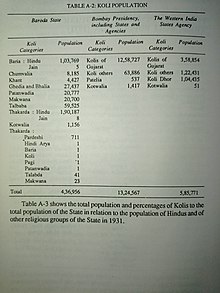Makwana (Koli clan)
The Makwana Koli[1] (also spelled as Makawana Koli, Makvana Koli,[2] Makavana Koli, Mukwana Koli and Mukawana Koli) (Hindi: मकवाना कोली) is a clan (Gotra) of the Koli caste mostly found in the Indian state of Gujarat and Union territory of Dadra and Nagar Haveli and Daman and Diu.[3] In 1931 census of Baroda State, there were 20,700 Kolis of Makwana clan in the Baroda state's territory.[4] Makwana Kolis mostly belong to the Hindu faith but there are members of the community who converted to Islam during the reign of the invading Mughal power in Gujarat.[5]
| Makwana Koli મકવાણા કોલી | |
|---|---|
| Clan (Gotra) of Koli caste | |
 Koli population in Gujarat in 1931 including Makwana Kolis | |
| Ethnicity | Koli people |
| Location | |
| Varna | Warrior |
| Parent tribe |
|
| Demonym | Koli |
| Branches |
|
| Language | |
| Religion | |
| Surnames | |
Makwana Kolis are landholders and agriculturist by profession.[6]
Principalities[edit]
Here are list of Princely States ruled by Makwana Kolis,
Notable[edit]
References[edit]
- ^ Perez, Rosa Maria (2004). Kings and Untouchables: A Study of the Caste System in Western India. New Delhi, India, Asia: Orient Blackswan. pp. 71: Three Koli Patel clans live in this village are Chauhan, Makwana and Rathod. ISBN 978-81-8028-014-6.
- ^ Kubala, Rameśa (1983). Gābīta Kshatriya Āramārī gharāṇyāñcā itihāsa (in Marathi). New Delhi, India, Asia: Kshatriya Kulāvatãsa Āramārī Marāṭhā Samāja. pp. 240: The Gazetteer states that the Chief of the State is a Makvana Koli.
- ^ Roy, Shibani (1983). Koli Culture: A Profile of the Culture of Talpad Vistar. New Delhi, India, Asia: Cosmo Publications. pp. 31: two clans of Kolis are recognised: the Mar and Makwana. These are exogamous clans referred to as 'atak. Each 'atak' is further subdivided into sub clans referred to as 'gram echap, ' in the local dialect. Besides the division of 'sacche Koli' the rest of the 222 'ataks' and those clans name are common to both the.
- ^ Lobo, Lancy (1995). The Thakors of North Gujarat: A Caste in the Village and the Region. New Delhi, India, Asia: Hindustan Publishing Corporation. p. 188. ISBN 978-81-7075-035-2.
- ^ Gode, Parshuram Krishna (1969). Studies in Indian Cultural History. New Delhi, India, Asia: Vishveshvaranand Vedic Research Institute. p. 51.
- ^ Vidyabhusana, Satis Chandra (1996). Buddhadeba, arthāt̲, Gautama Buddhera sampūrṇa jībana carita o upadeśa (in Bengali). New Delhi, India, Asia: Karuṇā Prakāśanī. p. 46.
- ^ Chakrabarti, Jadab Chandra (1895). The Native States of India. New Delhi, India, Asia: Shaw Publications. p. 128.
- ^ Gode 1969, pp. 51.
- ^ Department, India Foreign and Political (1892). A Collection of Treaties, Engagements, and Sanads Relating to India and Neighbouring Countries. New Delhi, India, Asia: Office of the Superintendent of Government Printing, India. p. 334.
- ^ The Hind Rajasthan, Or, The Annals of the Native States of India. New Delhi, India, Asia: Usha Publications. 1985. pp. 122–123.
- ^ "Ahead of Limbdi by-poll another former Congress MLA joins BJP". DeshGujarat. 2013-05-22. Retrieved 2023-07-02.
